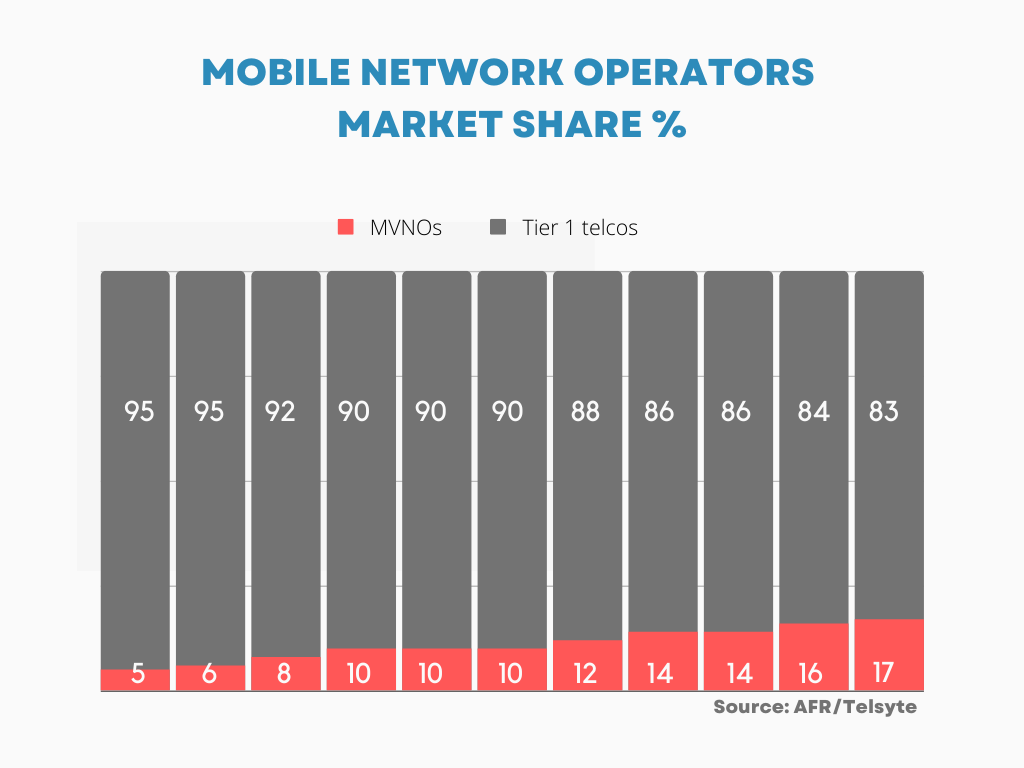Most Australians know that Telstra and Optus are the country’s two biggest telcos.

Therefore, you would have thought they have an almost duopoly on mobile phone contracts and SIM-only plans. However, whilst this is still the case, MVNOs are slowly but surely on the rise, and we predict this trend will continue. In 2011, MVNOs took up just 5% of the telecom market. But in 2021, that number was 17%.
Why are MVNOs becoming more popular?
This article will look at the three biggest reasons people are leaving Telstra and Optus for smaller companies such as Boost mobile and Lycamobile. Price increases. The rise of the eSIM. And inflation.
Price increases
The first reason is, of course, the phone contracts from the big two are becoming more and more expensive. Let’s take a look at Telstra, for example. Earlier this month, they announced they would be upping their prices by about $4 (per month) later this year.
Although some Telstra customers might pay a bit more or a bit less, one thing is for sure; if you’re with Telstra, you can expect your phone bill to rise.
Optus customers are also not immune from price rises. If you pay $60 for your phone, in the near future, you can expect to pay $70. And if you’re already paying $70, you can expect it to go up to $75. The underlying cause of these price rises is inflation. The cost of everything is going up. The materials used in the 5G towers, the general maintenance of the network, and other aspects of telcos are all rising. Telcos have passed this price rise on to their customers.
Because the big two are charging their customers more, people are looking for cheaper alternatives. MVNOs have become a popular choice because they share the same infrastructure network and many of the same services as Telstra and Optus, just at a lower price. Some customers may use less data or have fewer services (such as wi-fi calling) to lower their phone bills.
The rise of the eSIM
Another reason more people are opting for MVNOs instead of traditional telecoms companies is the rise of the eSIM. Traditionally, a SIM card is a small piece of metal you need to put into your phone. The SIM card controls your phone number, phone calls, text messages, and 3/4/5G data. If you wanted to change carriers, you would need to order a new SIM card and wait for it to arrive. But, what used to take weeks can now be done in days.
The eSIM is built into the phone and can change carriers much easier. By going to your phone’s settings app and changing your celluar plan, you can go from Optus to Aldi Mobile in less than five minutes. The changeability of the eSIM is beneficial for customers who want cheaper deals. They can easily switch whenever another MVNO or telecom company offers them a more affordable deal.
We should note that if you’re on a fixed-term contract, switching eSIMs is not always so simple. But, if you’re not on a contract or use SIM only, changing your provider is incredibly easy with eSIM. We should note, however, that not all phones are compatible with eSIM. Only phones with the hardware already installed are. But, such phones are becoming increasingly common.
Inflationary Prices
And the final reason is inflation. Earlier in this article, we discussed how inflation impacts mobile network providers. But, it also affects regular Australians, who need good mobile phone coverage, whether for work or leisure.
Around the world, the prices of everything from petrol to food to clothes are rising. Inflation has increased by 5.1%. Something that used to be $1 will now be $1.05. Despite this, real wages (average wage change adjusted for inflation) have shrunk by 3%. So, not only do many people now have less money, they have to make this money go further.
Therefore, more people are looking to save money wherever they can. And mobile phones are one of the many areas where people are becoming more frugal. If Telstra and Optus are raising their prices, it’s predictable that people will seek out cheaper options where they can.
Conclusion
Most pressing, in the eyes of Australian phone plan shoppers is cost of living pressure and what appears to be the rising likelihood of a global economic downturn in the months and years ahead. Phone plans are most commonly viewed, these days, as utilities – a life staple which we take for granted. (Just consider your own outraged response to a situation in which you try to make a phone call and can’t because coverage is bad or there has been a network outage.) Access to telecommunications services is a key part of life for all of us, these days. Paying over the odds for such a necessary service, on the other hand, is not. In the days ahead, it seems that the proportion of Australians signing up to MVNOs as a way to square the circle and provide themselves with a necessity at a better price.